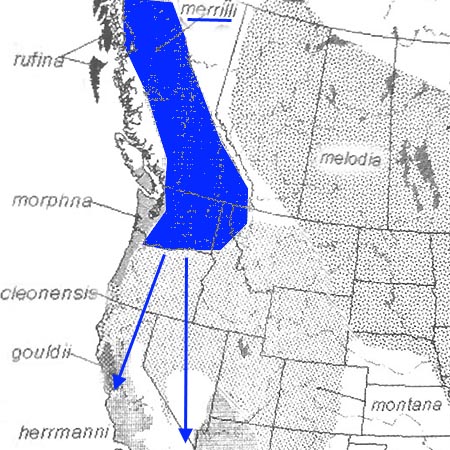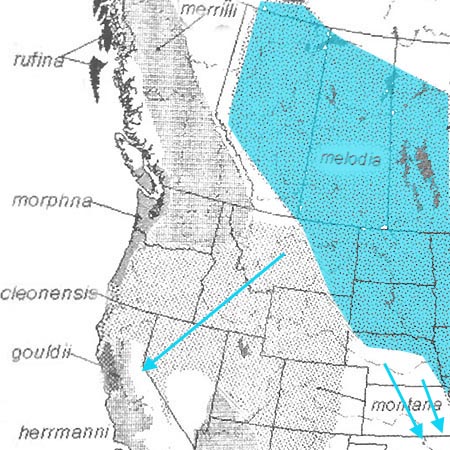| |
|
26 Nov 2005 west of Vancouver, Washington © Dennis Paulson
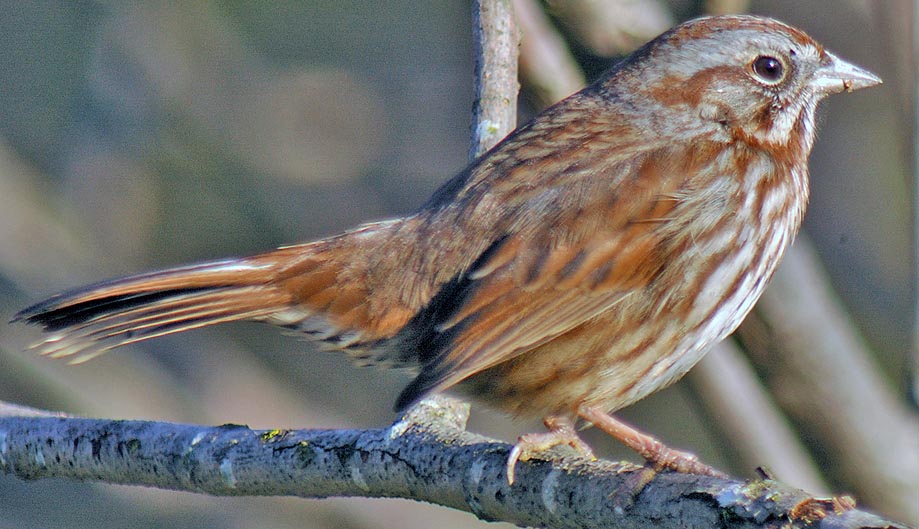 |
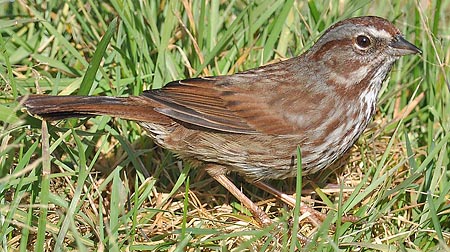 23 Mar 2011 Juanita Bay Park, King Co., Washington © Netta Smith
23 Mar 2011 Juanita Bay Park, King Co., Washington © Netta Smith |
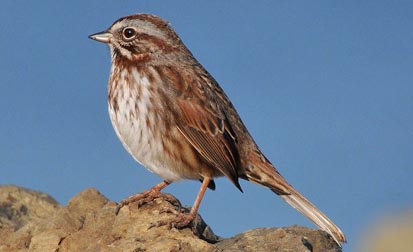 18 Dec 2011 Port Townsend, Washington © Dennis Paulson
18 Dec 2011 Port Townsend, Washington © Dennis Paulson |
Subspecies morphna
of the coastal Pacific Northwest is a dark rusty Song Sparrow with
grayish underparts and broad blurry rusty streaking to back and
underparts. The wings and tail are very rusty, and the facial pattern
is gray with rusty stripes (including the malar). As the underpart
streaks are not crisp and the background color is grayish, the entire
bird looks dark, richly rusty, and blurry. The subspecies is mostly
resident; three photos from within its usual range are shown above.
Some
portion of the population moves south in winter (perhaps the
northernmost birds?) into northern coastal California. These migrants
occur in very small numbers south to the S.F. Bay area and to Monterey
Bay. The photos below illustrate individuals in winter in Contra Costa
and Santa Cruz Co. There is a specimen labeled morphna, taken 15 Mar 1920 Carmel (#CAS).
|
|
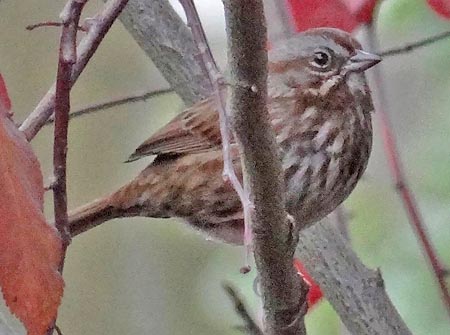 31 Dec 2012 Lafayette, Contra Costa Co. © John Asher
31 Dec 2012 Lafayette, Contra Costa Co. © John Asher |
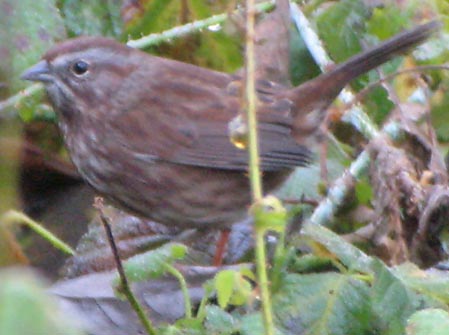 6 Jan 2011 Henry Cowell Redwood SP, Santa Cruz Co. ©Alex Rinkert |
|
| |
1 Apr 2011 west of Othello, Grant Co., Washington (southwest of Spokane) © Dennis Paulson
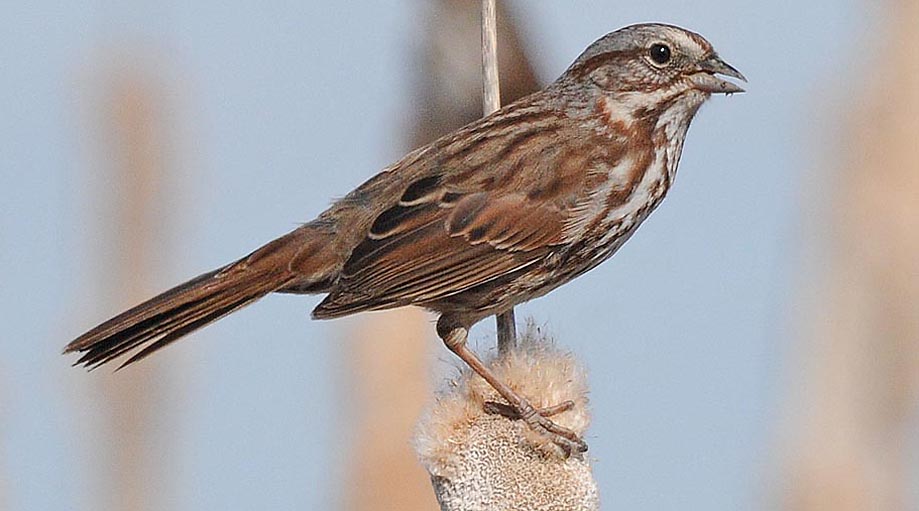
|
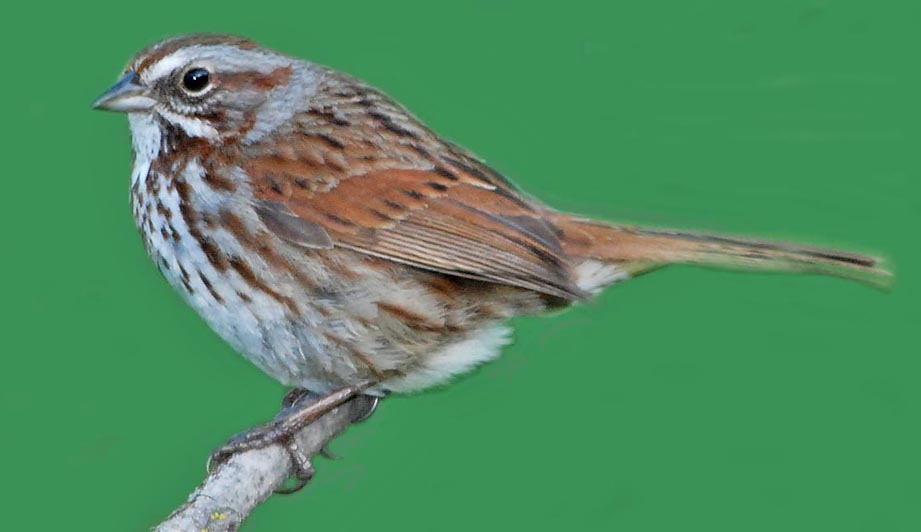 29 May 2009 south of Republic, Ferry Co., Washington (~40 mi S of the Canadian border) © Dennis Paulson
29 May 2009 south of Republic, Ferry Co., Washington (~40 mi S of the Canadian border) © Dennis Paulson |
Subspecies merrilli
breeds in the inter-mountain valleys of British Columbia south to
eastern Washington and northern Idaho. Arcese et al. (2002) describe it
as "similar to morphna but paler, grayer, with more well-defined, contrasting streaks." Patten & Pruett (2009) call it "intermediate between morphna and montana."
The two photos above are from different parts of its range in eastern
Washington, and there are obvious differences between them, with the
upper bird more like morphna but having decidedly crisper and
darker brown streaks below, while the second bird is much whiter below
than morphna, and more like montana in that character.
It
is partly migratory, with birds reaching southern California. It may be
more migratory and more common in California in winter than previously
thought, with a good number of specimens both coastal and inland
throughout northern California (P. Pyle, pers. com.). The photos below,
likely of the same individual at Carmel R. mouth, were tentatively
identified as merrilli by Michael Patten and Peter Pyle. If so, it would seem to be from the more eastern part of the range — more like montana than morphna
— because the underparts of white and the streaking (above and below)
more blackish, but still more heavily streaked below than montana. Alternatively, it could be an example of something from an intergrade zone, such as between a 'fisherella'-type montana [more on that below] and northernmost heermanni. Whatever its origins may be, it a migrant to coastal MTY from some breeding population far north of here.
|
|
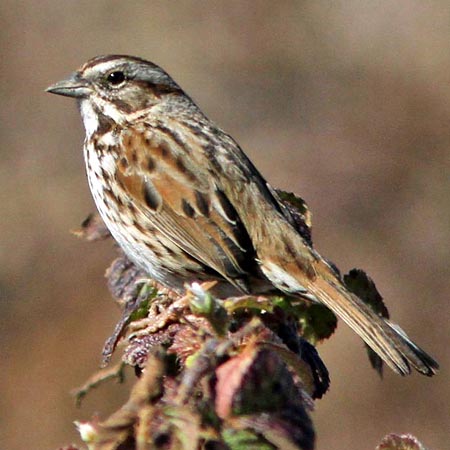 10 Feb 2013 Carmel R. mouth © D. Roberson
10 Feb 2013 Carmel R. mouth © D. Roberson |
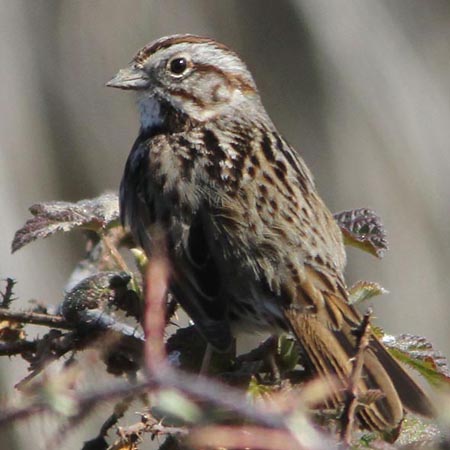 10 Feb 2013 Carmel R. mouth © D. Roberson
10 Feb 2013 Carmel R. mouth © D. Roberson
|
|
|
1Aug 2009 Madison River, Montana (just west of Yellowstone NP; adult carrying food to nest) © Tom Grey
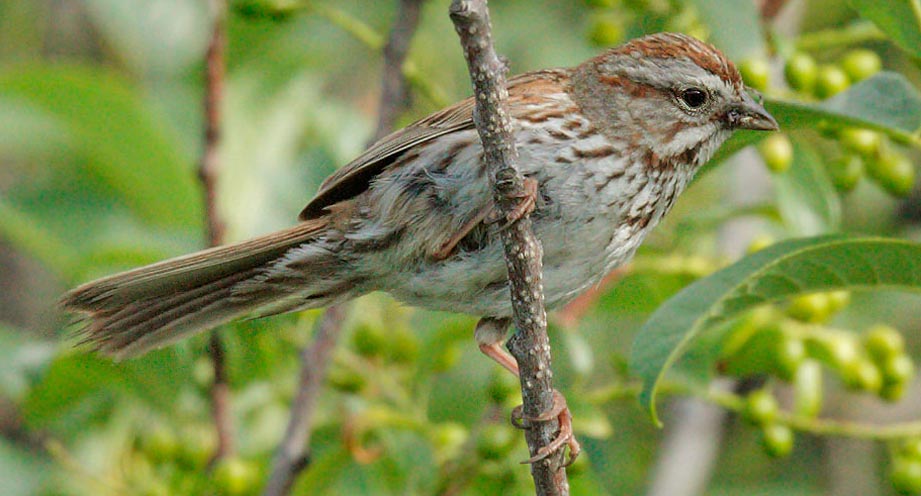 |
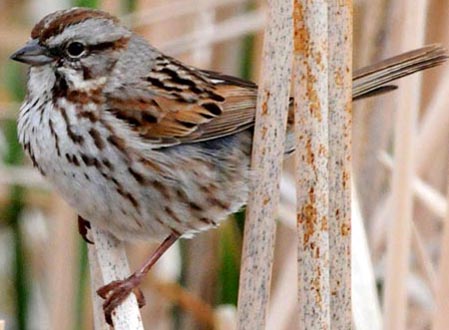 29 May 2010 Malheur NWR, Malheur Co., Oregon © Netta Smith
29 May 2010 Malheur NWR, Malheur Co., Oregon © Netta Smith |
 21 Apr 2012 Camas NWR, Jefferson Co., Idaho © Netta Smith
21 Apr 2012 Camas NWR, Jefferson Co., Idaho © Netta Smith |
Subspecies montana
breeds in the Great Basin region from east Oregon and northeast
California across to west Montana, and south into northeast Arizona,
northern New Mexico. The 'classic' montana Song Sparrow is
pale gray and red, white below, with chestnut malar and restricted red
streaking below. Examples are the Montana and Idaho birds above. The
old race 'fisherella' was merged into montana
(Patten & Pruett 2009) but a bird from that population is shown
just above, from Malheur NWR, eastern Oregon. Note that its combination
of pale gray above, white below, with some chestnut in malar and in
flank streaks, but also blackish streaking on the breast and back.
I've colored the northern part of the range of montana
on the map (right), because those populations are migratory south to
eastern California and north-central Mexico, and placed a green arrow
to the range of old fisherella (basically eastern Oregon/northeastern
California). There is a specimen labeled montana from San Lucas, Monterey Co., 19 Nov 1918 (#MVZ). Peter Pyle recently looked at the specimen and thought it could be merrilli or possibly a fisherella-type example of montana.
This winter a bird at Carmel R. mouth 9-10 Feb 2013, was pale gray
above and white below, with reduced breast streaking (below, both
photos). Michael Patten thought it was montana, and Pyle agreed it could be an example of 'fisherella', more like the Malheur bird (above) than the 'classic' red and gray montana.
Although the malar and breast streaking look blackish in one shot
(below left), another shows some chestnut in the malar (below right).
Pyle thought it most closely matched specimens taken in far
north-central California.
|
|
 10 Feb 2013 Carmel R. mouth © D. Roberson
10 Feb 2013 Carmel R. mouth © D. Roberson |
 10 Feb 2013 Carmel R. mouth © D. Roberson
10 Feb 2013 Carmel R. mouth © D. Roberson |
|
|
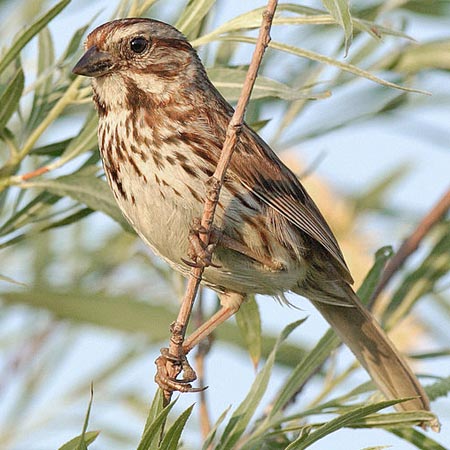 July 2005 Whitby, Ontario, Canada from Wikimedia Commons
July 2005 Whitby, Ontario, Canada from Wikimedia Commons |
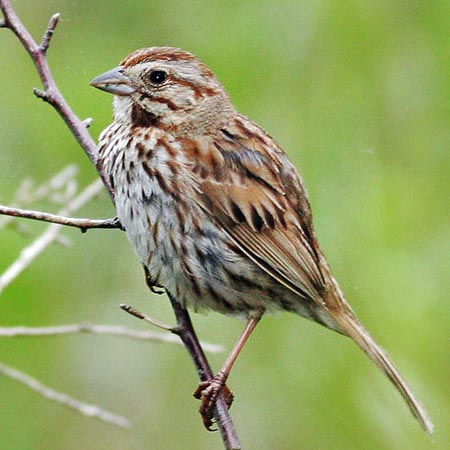 4 June 2006 Hammonasset SB, Connecticut © Tom Grey
4 June 2006 Hammonasset SB, Connecticut © Tom Grey |
Subspecies melodia
is the 'eastern' Song Sparrow, but like many 'eastern' warblers, it
ranges well west in Canada to Alberta and could occur in California as
a vagrant. It is a pale brown and white sparrow with chestnut streaking
above and below (much reduced streaking below compared to most CA
subspecies), and generally recalls a dull version of montana.
The upperparts are medium-brown, edged buff (rather than gray, per
Patten & Pruett 2009, but note a gray nape). To my eye these two
photos from its summer breeding grounds (Ontario, Connecticut) show
much less red in the wings and tail than our western birds, and perhaps
it could be identified on the comparatively plainness of plumage (no
doubt photo confirmation would be necessary).
Like
many 'eastern' warblers, its normal migration route is towards the
southeast, and sparrows from this nominate population winter in the
southeastern U.S. from Texas to Florida. However, like 'eastern'
warblers, fall vagrants could fly a 'mirror-image' of their route, head
SW instead of SE, and end up in California. There are as yet no records
for the Monterey Bay region, but I understand that vagrants have
reached California, so the possibility should be on our radar.
|
|
|
| |
Photos:
All photos on this page © Don Roberson, except those credited to
Tom Grey, Dennis Paulson, or Netta Smith, and used with permission, all
rights reserved.
Acknowledgments: I
thank Michael A. Patten and Peter Pyle for in-depth email discussions
of geographic variation in Song Sparrows (with photo examples); Tom
Grey, Dennis Paulson, and Netta Smith for providing many photographs to
review; and John Asher and Alex Rinkert provided photos of morphna
in CA (a few other photos were found on-line in the public domain).
Rita Carratello, Tom Grey, Marshall Iliff, Dennis Paulson, Alex
Rinkert, and Dan Singer also contributed to the discussions that
brought this revised page together.
Literature cited:
Arcese, P., M.K. Sogge, A.B. Marr, and M.A. Patten. 2002. Song Sparrow (Melospiza melodia) in The Birds of North America, No. 704 (A. Poole & F. Gill, eds.). The Birds of North America, Inc., Philadelphia, PA.
Grinnell, J., and W.A. Miller. 1944. Distribution of the Birds of California. Pac. Coast Avifauna 27. Cooper Ornith. Soc.
Patten
M.A. 2001. The roles of habitat and signaling in speciation: evidence
from a contact zone of two Song Sparrow subspecies. Ph.D. dissertation,
Univ. Calif., Riverside.
Patten, M.A. 2010. Evolution and historical biogeography of a Song Sparrow ring in western North America, pp. 329-342 in
Evolutionary Biology – Concepts, Molecular and Morphological Evolution,
Chapter 20 (P. Pontarotit, ed.). Springer-Verlag, Berlin.
Patten, M.A., and Pruett, C.L. 2009. The Song Sparrow, Melospiza melodia,
as a ring species: patterns of geographic variation, a revision of
subspecies, and implications for speciation. Systematics and
Biodiversity 7: 33-62.
Roberson, D. 2002. Monterey Birds, 2d ed. Monterey Pen. Audubon Soc., Carmel, CA.
|
|
|
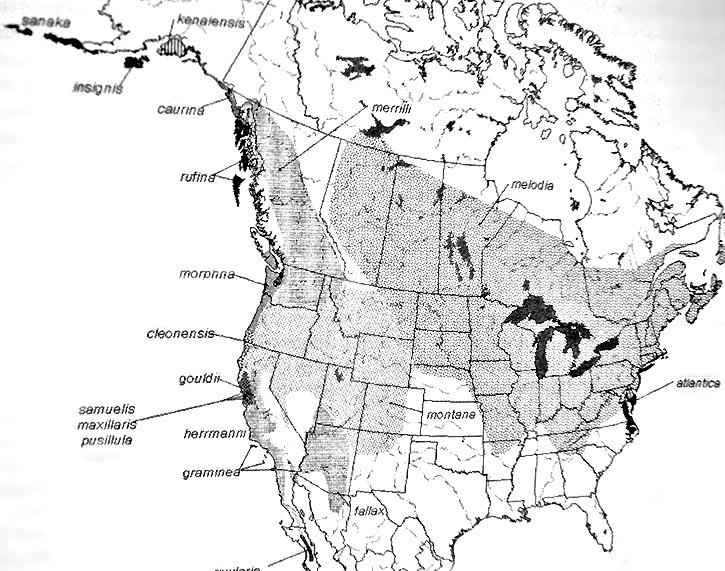



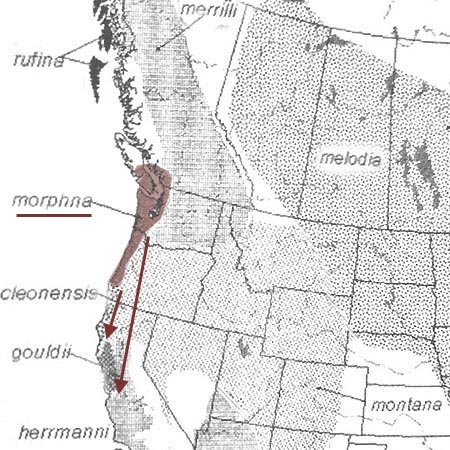

 6 Jan 2011 Henry Cowell Redwood SP, Santa Cruz Co. ©Alex Rinkert
6 Jan 2011 Henry Cowell Redwood SP, Santa Cruz Co. ©Alex Rinkert 

